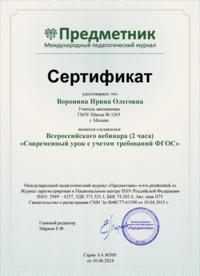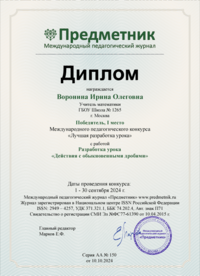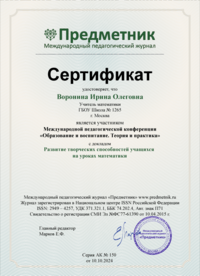Using a game - based platform Kahoot as educational technology
Конференция: Образование и воспитание. Теория и практика
Автор: Зуйков Антон Олегович
Организация: МБОУ Школа 41 «Гармония»
Населенный пункт: Самарская область, г. Самара
Kahoot! is used for formative assessment, to monitor each student’s progress towards learning objectives, identify strengths and weaknesses, and to identify areas where the students would benefit from more one-to-one teaching, more challenging learning opportunities, or a review of foundational knowledge for that subject. Though the results of each game can be downloaded to a PC and Google Drive, the results aren't that useful since they are just a graph showing whether the student got a question right. The results are not a very good representation of the student's knowledge. Many teachers and parents have concerns about Kahoot, as many children may randomly guess answers or cheat for a better score.
More experienced users also integrate kahoots into their curriculum to introduce new topics, increase retention of new facts, revise prior to exams, challenge classrooms around the world, survey opinions, gather insights, facilitate discussion, or to reward and re-energize learners.
The majority of Kahoot!’s users are students and teachers in K-12 classrooms, with growing numbers across colleges and universities and post-graduate education. Businesses also use Kahoot! for workplace training and staff inductions.
Kahoots are created using a drag-and-drop interface which allows teachers and other creators (including students) to build and customize multiple choice quizzes, using publicly available images and videos or their own teaching materials. Creators also have the option of duplicating one of the 7 million public kahoots created by other users, and adapting it for their own classroom.
Kahoot! is designed for social learning, with learners gathered around a common screen. In a typical classroom environment, this will be a smartscreen, interactive whiteboard, or a computer monitor. Many kahoots are also played using screensharing tools such as Skype, Appear.in and Google Hangouts.
When a kahoot is launched, it will have its own unique PIN number randomly generated by the system. Using any device with a web browser, players visit the website dedicated for quiz participation, kahoot.it, and input the unique PIN number, and then enter a nickname before being directed to the waiting screen (the "lobby"). When all players' nicknames appear in the lobby, the kahoot leader (normally the teacher) clicks the Start button to begin the quiz.
During Gameplay, the questions and up to 4 multiple choice answers are displayed on the main screen. Every answer corresponds to a distinctive color and shape. On the screen of the learners' devices, there are at most four rectangles with the color and the shape on each, and the learner needs to click or tap on the rectangle representing the correct answer. The game design is such that the players are required to frequently look up from their devices, enabling social interaction with the teacher and their peers.
For every question answered correctly, a number of points (with a maximum of 1000, depending on the time the student takes to answer the question) is awarded to each learner. At the end of every question, the learner sees his current score and his ranking in the class on his own screen. The learners with the 5 highest scores are displayed on the Leaderboard on the main screen as well, to encourage healthy competition amongst players.
Supported device Influenced by the "bring your own device" trend, Kahoot! aims to support a wide range of web browsers and mobile devices through its web interface, including Android 4.0 or later and all modern web browsers. There is also a native application for Android available, and according to Kahoot! apps for other platforms are planned but not the top priority.
The Kahoot! pedagogy is based on creating a trusted learning space, encouraging a loop from “learner to leader”. Devised from typical behavior, gaming and teaching models, the Kahoot! pedagogy creates a cycle which encourages both independent or collaborative research and creation, whilst also empowering learners to present and share their new-found knowledge to their peers, in a playful and social manner. Deeper learning happens when learners consider not just what the correct answers are to questions, but also what the potential incorrect answers are.
- The teacher introduces a topic using a kahoot designed to prompt debate, critical thinking and active learning. He or she normally supplements the kahoot with instructional images and video.
- Once the leader or teacher has introduced the topic, they play a kahoot designed for Formative Assessment, to assess and improve upon the learners' understanding of the topic.
- The teacher leads the class in other activities, discussions and related quizzes to consolidate the learners' knowledge. In some cases the class may play the same quiz multiple times in "Ghost Mode" to reinforce learning through repetition.
- The teacher then asks learners to create their own quizzes on the same or related subject.
- Learners research, build up knowledge and gather or create relevant content, and then create their own quizzes using this content.
- The learners, or groups of learners, are then empowered to become leaders as they play their quiz back to classmates.
- Teachers can assess their understanding and approach based on the quality of their content, structure of the kahoot and how they have explained the correct answers to their peers.
Kahoot! was developed by its three founders, Johan Brand, Jamie Brooker and Morten Versvik, as a joint project between Mobitroll and the Norwegian University of Technology & Science.
The core quiz format is based on research by Professor Alf Inge Wang and colleagues at the Norwegian University of Science and Technology (NTNU). The technology platform itself stems from research conducted by Morten Versvik as part of his master's degree at NTNU. The Pedagogy and User Experience were informed by the work co-founders Jamie Brooker and Johan Brand developed while at their London-based behavioral design agency, We Are Human.
Kahoot! is owned and funded by the founding team, and has also received grant funding from the Norwegian Research Council.
Reference
- "Kahoot!". Kahoot!. Retrieved 2015-09-17.
- "Kahoot! - Android Apps on Google Play". Google Play. Google Inc. 9 June 2014. Retrieved 2 March 2014.
- "Kahoot is a Fun Free Game-Based Classroom Response System — Emerging Education Technologies". www.emergingedtech.com. Retrieved 2015-09-17.
- Wang, Alf Inge (12 November 2014). "The wear out effect of a game-based student response system" (PDF). Computers & Education. doi:10.1016/j.compedu.2014.11.004. ISSN 0360-1315.
- Jump up to:a b "The Norwegian Winners of the Nordic Startup Awards 2015". Nordic Startup Bits. Retrieved 2015-09-17.
- Europe, EdTech. "DigiSchool, Kahoot! and RefME Announced as Winners of 2015 EdTech 20". www.prnewswire.com. Retrieved 2015-09-17.






